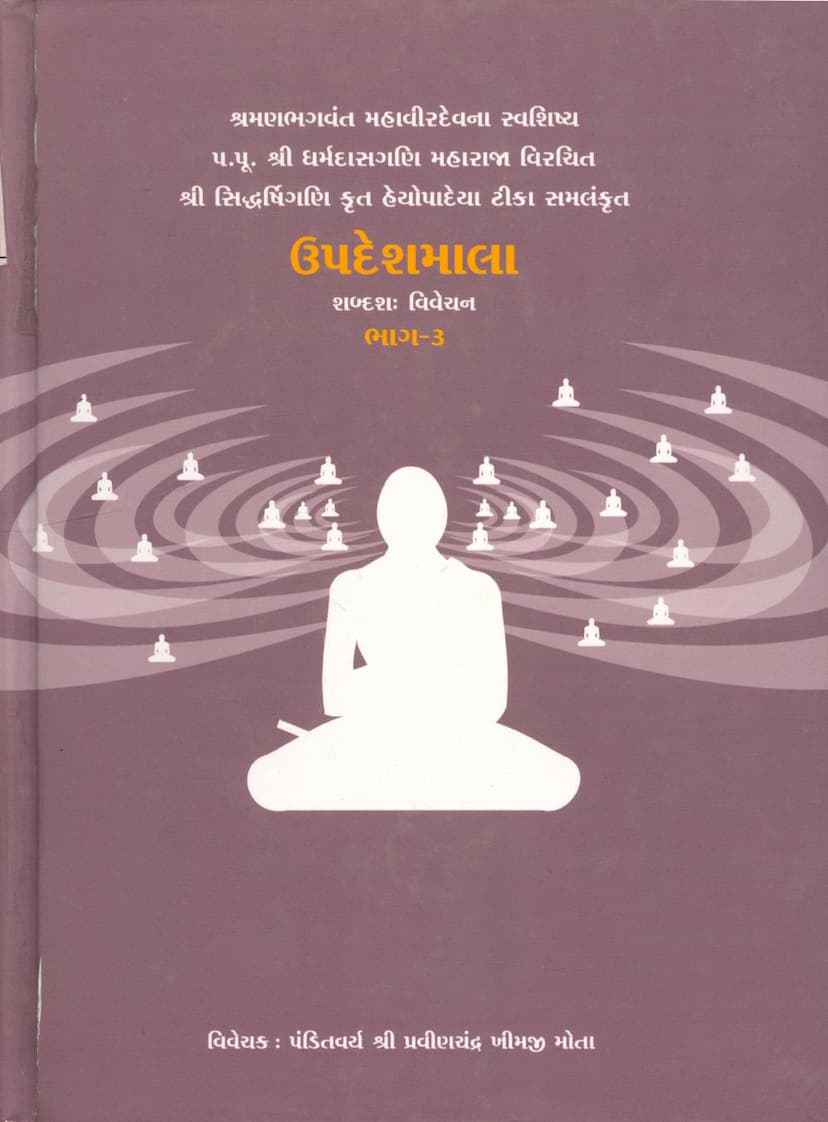Updesh Mala Part 03
Added to library: September 2, 2025

Summary
Here's a comprehensive summary of "Updesh Mala Part 03" by Dharmdas Gani, Siddharshi Gani, and Pravin K Mota, based on the provided Gujarati text:
Title: Updesh Mala: Word-by-word Commentary, Part 3 Original Author: Shraman Bhagwan Mahavirdev's own disciple, P.P. Shri Dharmdas Gani Maharaj Commentary (Tika): Shri Siddharsigh Gani (Heyopadeya Tika) Commentator (Vivechak): Panditvar Shri Pravinchandra Khimji Mota Publisher: Gitarth Ganga Edition: First Language: Gujarati (with Sanskrit verses and commentary) Year of Publication: Veer Samvat 2541 - Vikram Samvat 2071
Overall Purpose:
This book is the third part of a detailed word-by-word commentary on the "Updesh Mala," a significant Jain scripture. The original text is attributed to the direct disciple of Lord Mahavir, Shri Dharmdas Gani, and is further elaborated by Shri Siddharsigh Gani. The current volume focuses on the commentary and analysis provided by Panditvar Shri Pravinchandra Khimji Mota, under the guidance of esteemed Jain Acharyas. The primary aim is to explain the profound teachings of the Updesh Mala in a clear and accessible manner, making the complex philosophical and ethical principles understandable to a wider audience.
Key Themes and Content (Based on the Table of Contents and Sample Pages):
The text, as evidenced by the table of contents and the initial verses, delves into various aspects of Jain philosophy, ethics, and practice. It appears to be a detailed exposition of the original Updesh Mala, aiming to clarify the "Heva" (what should be abandoned) and "Upadeya" (what should be adopted) aspects of conduct and spiritual understanding.
The summary can be broadly categorized by the topics covered in the chapter-like breakdown (Anukramanika):
- The Nature of True Asceticism (Yati Dharma): The text distinguishes between genuine ascetics and those who merely wear the guise. It emphasizes the importance of right knowledge, perception, and conduct (Yati Dharma) over mere outward appearance. It highlights the qualities of a true monk and the pitfalls of ignorance.
- The Essence of Dharma: It explores the true meaning of Dharma, contrasting it with mere ritualistic practices. The comparison with worldly activities like income and expenditure analysis (Ay-Vyay) is used to underscore the importance of understanding the true principles of spiritual practice.
- Ethical Conduct and Avoidance of Transgressions (Atichara): The text details various transgressions (Atichara) that ascetics and householders must avoid. It emphasizes the need for meticulous observance of vows (Vratas).
- The Importance of Knowledge (Gyan) and Its Limitations: While stressing the paramount importance of knowledge in the path to liberation, the text also cautions against mere intellectual understanding without corresponding conduct. It highlights that knowledge without right conduct is futile.
- The Dangers of False Asceticism (Kuta Chariya): A significant portion of the text seems dedicated to exposing and condemning false practices, hypocrisy, and deceitful conduct among those who claim to be ascetics. The examples of "Kuta Charyit" (deceitful conduct) and "Kapata Kshapak" (hypocritical ascetics) are likely used to illustrate these points.
- The Significance of Virtues and the Dangers of Vices: The text likely discusses virtues like forgiveness, non-violence, truthfulness, etc., and contrasts them with vices like greed, anger, ego, and attachment.
- The Path to Liberation (Moksha Marg): The core of the Updesh Mala, and its commentary, lies in guiding the reader towards the path of liberation. This involves understanding the principles of Jainism, practicing right conduct, and cultivating spiritual virtues.
- The Role of a Spiritual Guide (Guru): The importance of a genuine spiritual guide in imparting true knowledge and leading one on the right path is likely a recurring theme.
- The Value of Auspiciousness (Mangal) and Right Conduct: The text emphasizes the importance of adhering to the teachings of the Jinas and following the right path.
- The Relationship Between Knowledge and Conduct: The text stresses that true spiritual progress comes from the harmonious integration of knowledge (Gyan) and conduct (Charitra). Mere intellectual knowledge without practice is deemed ineffective.
- The Meaning of "Updesh" (Instruction): The teachings are presented as instructions aimed at the well-being of the soul (Atma Hita), guiding one away from harmful actions (Ahita) and towards beneficial practices.
Commentary Style:
The commentary by Panditvar Shri Pravinchandra Khimji Mota is described as "Shabdshaha Vivechan," meaning a word-by-word explanation. This suggests a meticulous and detailed analysis of the original text, aiming to uncover the subtle meanings and implications of each verse and concept. The commentary likely draws from various Jain scriptures and philosophical traditions to provide a comprehensive understanding.
Spiritual Lineage and Support:
The publication is blessed by revered Acharyas like H.H. Acharyadesh S. Shrimad Vijay Ramchandrasoorishwarji Maharaj and H.H. Acharya Bhagwant Shrimad Vijay Yugbhushansureeshwarji Maharaj, indicating a strong spiritual backing and lineage.
Overall Impression:
"Updesh Mala Part 03" appears to be a scholarly and spiritually significant work that aims to illuminate the path to liberation by providing a detailed explanation of the Updesh Mala. It emphasizes ethical living, the pursuit of knowledge, and the importance of right conduct, all within the framework of Jain philosophy. The commentary by Panditvar Shri Pravinchandra Khimji Mota is presented as a valuable resource for those seeking a deeper understanding of these teachings.